



This is your Earth...on Rocks

Artworks by Don Davis (unless otherwise noted)




T-Rex Vanquished by Space Rock?
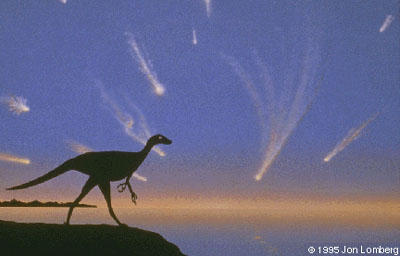












For 150 million years—longer than the reign of mammals, so long that, by comparison, the Age of Man is as a toddler to a patriarchal grandparent—Tyrannosaurus Rex (T-Rex to the initiated) and his ilk (above) dominated the Earth until the end of the Cretaceous Period and then, abruptly, passed into paleontology.

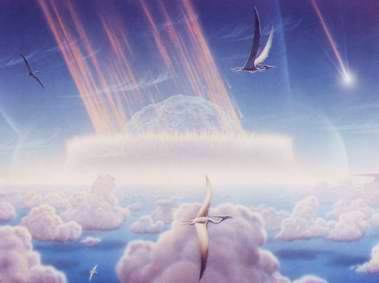
Scientists have discovered a roughly 30-million-year cycle of such events in the prehistoric record. And, no natural pulse explaining this cycle could be determined until 1984, when astrophysicist Richard Muller and his colleagues published their theory: the extinction cycle is caused by a dark, solar-companion star, dubbed Nemesis or Death Star, orbiting the sun once every 24-30 million years. Such a star (probably a red dwarf) has been suspect since at least 1975, and a decade later Muller tied the yet-to-be-found Nemesis to the extinctions, theorizing that on its way into the solar system it perturbs the Oort Cloud sending comets plunging toward the sun in its wake. This is a likely theory, as most stars are doubles, and the existence of such a star would be very difficult to confirm by observation or gravimetric mathematical prediction. Galactic oscillation’s opposing gravimetric force is also believed to disturb the Oort cloud, regularly sending comets inbound toward the sun, and the Earth.
Earth has the fortuitous shield of the Solar System’s outer planets—the gas giants—which, for billions of years, like Jupiter did with Comet Shoemaker-Levy 9 (above), have stood between Earth and the other inner planets, sweeping away many inbound comets. But, adding to the likelihood of disaster are the over 100,000 asteroids more than 100 meters across which, speeding silently on fateful courses, pass close to Earth and are predicted to eventually strike the inner planets, including the Earth and Moon, within the next 100 million years.
The most recent major impact was on June 30, 1908, when an estimated 100,000-ton, stoney asteroid, 60 meters across, traveling at 12 miles per second, probably from Beta Torrid complex, entered the atmosphere at nearly a 30-degree angle and vaporized about six miles above the 100 sq. miles of Siberian forest which it leveled as it released the energy equivalent of 1000 Hiroshima bombs and sent a plume towering into space that reflected enough sunlight to create global bright nights for days. Called the Tunguska event, impacts of this magnitude seem to occur every hundred years.
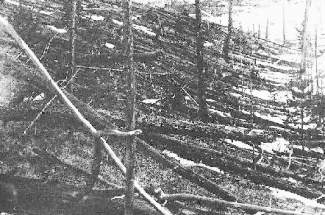
Tunguska Event
Devastation replaces once-lush forest, less than a half-mile from
the impact site and a decade later.

Yet, asteroid impacts have created as well as destroyed. Two billion years ago, the impact of an Apollo in Ontario, Canada seeded such quantities of nickel that more than half of the world’s supply has been mined from its deposits in the last quarter-century.Although the K-T impact is the accepted trigger to the extinction of the dinosaurs, some scientists remain skeptical that a collision with a large asteroid could, of itself, explain the mass extinction. They cite evidence of fossilized trees, unlikely to exist in the weather T-Rex preferred, as a clue that the onset of dramatic climatic change to a cooler, seasonal system was already well under way at the time of the extinction and that the asteroid may have only speeded the giant reptiles’ eventual departure. They also point to the many species (of both land and sea) which were already extinct before the end of the Cretaceous, and to the existence of other reptilian species which were not severely affected by the cosmic-borne catastrophe. But, to those swayed to concede a greater significance to the 90-percent kill-effective aftermath of the impact extinction, there are explanations for the reptilian species which survived: they being either small enough to reduce their metabolism in the shelter of rock crevices and buried beneath the killing cold, like the skinks and gekos, or being aquatic, like tortoises and crocodiles, using heat-retaining waters to move to warmer, survivable (for them) habitats. And, although the record of plant evolution along the Cretaceous boundary layer can be argued not to support a collision-induced extinction, or at least not all of the effects such a collision is hypothesized to have produced, it is difficult to gauge the validity of conclusions drawn on relationships where a rapidly changing environment formed the backdrop to many unpredictable climatic and evolutionary factors.
The asteroid hit is evidenced by several factors, chief of which is the discovery of a layer of iridium in a clay strata of the Earth’s crust, located in the very same stria of sediment found in different samples from several widely-spaced, global regions. The event is confirmed by the coexistence (with the iridium in the clay) of tektites, fine particles of stressed quartz, which can only be formed by violent exposure to extreme heat and pressure, and which are similar to samples found near meteorite craters and atomic bomb test sites.
Iridium continuously rains down on the Earth, being a part of the estimated 100,000 tons of cosmic dust swept from space by the atmosphere on each circuit of Earth’s orbital path, much like a whale in the ocean filters organisms through its maw as it swims. Over time, normal stratification of sediments is accompanied by an expected, measurable content of iridium, making it possible to determine the time taken for the layer to form, more iridium indicating a longer formation period. Limestone deposits separated by the clay (containing the iridium and stressed quartz) mark the boundary layer of the Cretaceous- Tertiary Periods.
In the Cretaceous-Tertiary layer, wherever it is encountered, iridium is found to be far in excess (by a factor of 30) of levels expected through normal geochemistry. It is argued that the excess amounts must be of extraterrestrial origin (the asteroid) and had accumulated in a short period of time during a single astronomical event (the impact).
So cataclysmic an impact should also leave a geologic imprint, but the search has found the smoking gun to be elusive. A primary clue to the location of meteor craters in geologically inactive bodies exposed to erosion is a displacement of bedrock, with the structure of the rock strata preserved, but inverted from that of the surrounding, adjacent strata. In a search for the impact site of a large-enough, culpable object, it was quickly determined that none of the known craters on current land masses qualifies; however, it is possible that an asteroid six miles (10 km) across, impacting the atmosphere at nine miles (15 km) per second in a plunge to the mid-ocean ridge between the continents, would penetrate the ocean floor’s crust creating a huge volcano that would eject material for years, forming a new land mass. Such a body of land, 60 million years old, does exist along the Mid-Atlantic Ridge: Iceland. Further, the iridium levels in the strata layers increases from 30 to as much as 160 times normal as the distance from Iceland decreases. Case solved??
Iceland’s emergence from vulcanism is natural enough and not dependent on cosmic interference, given its location on the Mid-Atlantic Ridge, an ancient geologic embryo. But the eruption could have been coincidentally timed, or triggered by an impact elsewhere near the Ridge. The northward-increasing pattern of iridium deposits could also be a consequence of other factors, such as incomplete surveys, distribution of ejecta by wind, the characteristics of which may have been unlike today’s patterns of circulation, or a flow influenced by the stronger magnetic field of the poles at the time. Generally, any mid-ocean impact would result in greater iridium deposits in adjacent coastal land masses on both sides, trailing off inland, and any drift of the crust over the last 65 million years has accordingly displaced those areas. In that time, fully half of the Cretaceous sea floor has been folded into the mantle beneath the continents as new sea floor has been created.
Now, the principally suspected impact site is the Chicxulub impact basin, discovered in 1990 using seismic monitoring equipment.
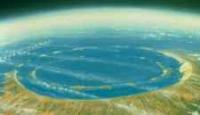
Located at the shallow Bay of Campeche, situated adjacent and southwest of the Gulf of Mexico, bordered on the east by the Yucatan Peninsula and the west by Veracruz, Mexico, a crater 115 miles in diameter, from ten to 20 miles deep, which dates back 65 million years, is buried a half-mile beneath the surface and is evidence of an asteroid impact associated with the semi-circular, coastal perimeter of this bay; it represents an impact field at least 150 miles in diameter, more than large enough to have spelled doomsday for T-Rex and the other higher forms of life then on the planet.
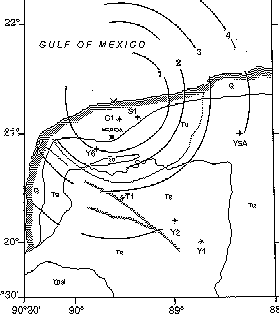
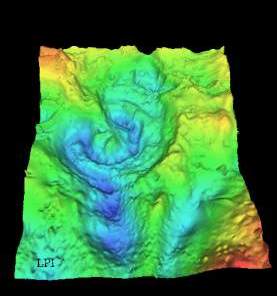
Graph (above left): Surface geology, ring locations from gravity data, and wells near the Chicxulub impact basin. The three wells that penetrated impact melt rocks and breccias beneath the carbonate cover rocks are C1 (Chicxulub 1), S1 (Sacapuc 1), and Y6 (Yucatan 6). The crater center is indicated by "x." Hatchured lines represent the Ticul fault system. Dashed lines indicate trend of ringlike zone of water-filled sinkholes.Image (above right): 3-D map of gravity and magnetic field variations from the impact basin, which is buried by hundreds of meters of sediment. This image shows an oblique view from approximately 60 degrees above the surface looking north, covering 88 to 90.5ø west longitude and 19.5 to 22.5ø north latitude.




Today, due to the impact of Jupiter by comet Shoemaker-Levy 9, which appears as the String of Pearls above, as seen by the Hubble Space Telescope in May 1994 (Jupiter image added for effect), and because of the speaking-out by astronomers and the exploitation of natural disasters by the motion picture industry, there is an increasing awareness of the danger we, as a civilization, face as a consequence of the many objects, known, and as yet unknown, which pose a real threat of surprise annihilation, ranging from at least regional to global magnitude. Even an asteroid of modest size (about 200 meters, which come along every 4,000 years) hitting the Pacific would wipe out Pacific coastal cities, like Tokyo, with the resultant 800-foot-tall tsunami, killing millions and slicing the body of the world economy in half. The Pacific is 30 percent of the Earth’s surface, so the mathematical probability of a Pacific hit is about once every 2000 years. The United States congress has authorized action, serious questions and answers are being exchanged about our ability to respond to the inevitable, and NASA’s Jet Propulsion Laboratory and the U.S. Air Force have joined to create the Near-Earth Asteroid Tracking project (NEAT), to locate, identify and track dangerous objects and form a more realistic evaluation of the threat.Sandia National Laboratory used the dynamic 3-D computational simulation of a comet impact the size of Shoemaker-Levy’s largest fragment (1 km) in the Atlantic Ocean off New York to test its new teraflops super computer. The simulation brought the Jupiter impacts home, confirming predicted parameters of the catastrophe that would follow, including the complete overwash of distant low lying areas, like Florida.
In 1996, the first international body to begin a task that could be accomplished within a quarter century with proper funding was created in Rome to organize programs of study and discovery of near-Earth objects, but subsequently, the Spaceguard Foundation went IDS and died before it could crawl, and only one-million dollars was appropriated to the effort. However,the only official program, aside from NEAT, that is actually searching for trouble is the University of Arizona’s Spacewatch program. NEAT and Spacewatch together received, by any standard, insignificant funding in relation to the danger to Earth their efforts seek to prevent. Considerably more is being spent, indirectly, to develop the capability to destroy threats, through U.S.A.F. space weapons development funding and the missions those programs create, like Clementine II, a satellite that will send a small missle into an asteroid, and which represents our first attempt to learn how we can affect dangerously sized objects, to move or destroy them.
On July 31, 1997, one year after the NASA-Air Force effort to locate dangerous Earth-crossing asteroids began, only ten percent of the sky had been surveyed. But that small section of space yielded seven objects greater than a half-mile across, the orbits of which won’t pose a threat to Earth for at least the next 200 years, and searchers are finding new Earth crossers on the average of about 300 a year.
The latest asteroid discovered, on July 5, is a mile-wide (20 times the size of the meteorite creating the Tunguska Event and one-tenth the size of the K-T Event asteroid) and will pass to within five million miles of Earth. Over the 20 years it is estimated it will take to complete the survey, scientists expect to locate, on average, 100 half-mile-or-greater diameter Earth-crossing objects every year. The time-line on impact with one of these "minor planets" is once every 100,000 years, a cycle within which our time left is unknown. NASA’s goal is to attain detections at least 100 years before impacts.
Some say the greatest threat facing all of mankind, or at least, significant segments of it, is a comet or asteroid impact. The more insidious threat is probably infectious and organic, but the global effort to prepare for a real pandemic is only slightly ahead of the resources countering the impact threat. Omit chance or bad luck from the equation, and the greatest threat to mankind are the small minded, narrow visioned, politically and self-motivated heads of government buried in the sands of the world, where diverted by war or greed or stupidity, disaster will be allowed to come rushing.




In an explosion described as being like a propane gas tanker igniting, a meteorite of unknown composition and believed to be as large as a car broke up and scattered fragments over the ground in New Zealand on Wednesday, July 7, 1999. There was no damage, and none of the fragments were recovered.Hundreds of people, including pilots and air traffic controllers, reported the meteorite as it cast an eerie blue light in the sky over a remote part of New Zealand’s North Island before finally disintegrating.
On November 17, the Earth passed through the remnants of the tail of Comet Tempel-Tuttle, and the sky over the western Pacific was the backdrop for a spectacular display of up to 1,000 meteors per minute. The onslaught, dubbed the Leonid meteor shower, although harmless to the Earth, was a threat to the world’s orbiting satellite systems, and what precautions that could be taken by positioning adjustments were made and there was no damage done. NASA launched a balloon with a video camera that hovered at 100,000 feet and provided views of the event which can be reviewed on the Internet.Much more ominous was the warning of Thai astronomer Khao Muanwong, the former dean of a Thailand university science department, that the mile-wide-plus comet is going to collide with Earth in its third-next fall toward the Sun, on November 15, 2097, inflicting global-wide destruction and annihilation on a scale that could close the curtain on the existance of mankind and countless other more evolved forms of life.
Kaho’s calculations are based on a database developed by a NASA scientist, and he says that others are aware of the probable impact but have been withholding the news from the public. If the projection is correct, scientists should be able to confirm it by the same method they discounted the initial prediction by University of Arizona Spacewatch program scientists that asteroid 1997 XF11 would pose an impact threat. Otherwise, in the longer term, independent confirmation of the comet’s trajectory should be possible after it’s next orbit is completed, in about 33 years.
The Kunia-Urgench region of Russia became ground zero for a meteorite estimated to be three-feet long and 600 pounds, which dug a 12-foot-deep crater when it impacted on June 20, 1998. There were no casualties or reported damage, despite that the object fragmented on impact, scattering its debris.
Called by scientists the most dangerous asteroid yet discovered—possessing enormous destructive potential—the Apollo asteroid 1997 XF11 is on a rondevous with Earth—a convergence that could be no closer than 180,000 miles or as near as...impact. At least those were the parameters initially reported by the International Astronomical Union (IAU).Discovered December 6, 1997, by the University of Arizona Spacewatch program, 1997 XF11 became the 109th object cataloged as posing a potential danger to Earth, and was the only asteroid of its size destined to so closely threaten the planet.
If the asteroid does impact Earth, it will release energy equivelent to 200 Hiroshima-type nuclear bombs. If ground zero is on land, the expected crater would have a diameter of about 20 miles, and the debris released to the atmosphere could darken the sun for months, triggering severe food shortages and unpredictable, extreme weather systems. Oceanic impact would provide no relief, generating a tidal wave hundreds of feet high, reducing coastal cities to mud flats and creating extreme continental coastline flooding. One and a half billion people of an estimated six billion world population would perish.
Astronomers said several more years of tracking are needed to make a precise calculation of the asteroid’s trajectory, but with initial observations, the object was estimated to pass inside the orbit of the Moon, 24,000 miles from the Earth’s surface. In any terms, that is too close for comfort, and there was a margin for error of more than 180,000 miles—almost the mean distance of the Moon from the Earth. That margin will decrease as the precision of the trajectory increases over time.
Not being able to exclude the possibility that the asteroid will impact the planet, the only good news this holds is for the Baby-boomer-and-before generations, all of whom will either be gone or in the late twilight of life if the clock on this rock reaches zero, which will be, based on the best current estimate, just after lunch on Thursday, October 26, 2028.
This time-to-disaster factor may explain, at least to government cover-up critics, why it was that (only hours after these foreboding announcements from usually cautious, nitpicky, precision-driven, astronomers, who with their sophisticated computers work specifically to warn of this type of danger) NASA and JPL—U.S. government scientists—needed no time at all to tweak the figures and amend the predictions, saying the asteroid will pass no closer than 600,000 miles. Nonetheless, Spacewatch scientists stand behind their calculations. But, the government’s interest in reducing the threat is hardly surprising, what with the possible doomsday still 30 years off, and with increasing anxiety during a two-year wait for a refined calculation, why risk creating public panic, moral disintegration, get-it/do-it-before-it’s-over economic chaos, lawlessness and anxiety now? JPL scientists have said that scanning old pre-discovery photographs provided the timeline needed to quickly refine the calculations, but it seems that simple research step would have been taken before before issuing a doomsday announcement; otherwise, how we go from the I.A.U. prediction of a 180,000-mile margin of error on a very iffy 24,000-mile close-pass one day, to a NASA-claimed 600,000-mile miss the next, is about that far beyond this writer. In any case, the orbit of this one could be altered by a universe full of things, slinging it right into our soup, even if it really isn’t bound to land in it now. Until there is a concensus, keep that safe room you go to for tornados ready.
One positive step taken in the shadow of this object’s threat was the decision by NASA to establish a program to locate and track at least 90 percent of the estimated 2,000 Earth-crossing objects which are two-thirds of a mile or greater in width. NASA’s Near-Earth Object Program Office will be headed by Donald Yeomans, the same JPL scientist who deflected the IAU’s 1997-XF impact report.
But, in establishing some sort of insurance against the impact threat, we take steps back, as well. In October 1997, President Bill Clinton used his line-item veto to cut the $30 million "Clementine" Asteroid Intercept Technology Demonstrator. The project would have tracked asteroids and sent spacecraft to intercept them. California Representative Dana Rohrabacher, chairman of the space subcommittee of the House Committee on Science, called on Clinton to reinstate the program, saying, "This project would have been a low-cost proof of [a system concept] to protect our planet from an asteroid collision."
One good reason to press on with the space station, moon bases and Mars colonization, aside from Earth benefits to technology and the environment, is that these programs are the best way to insure the proliferation and survival of the Human species if all else fails to prevent a doomsday impact.
But, for those ready-to-panic and head-for-the-hills frightniks who can’t sign-on to an off-world assignment, it’s nice to know there’s insurance to be bought, cheap... just in case. I guess, though, you have to be out of the house when one hits to collect.

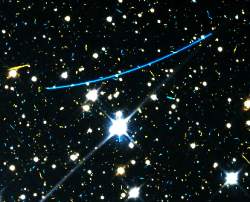
Danger within the Void
The picture is a Hubble Space Telescope image of the track of Apollo asteroid 1997 XF11, captured against the constellation Centaurus, 87 million miles from Earth and 156 million miles from the sun. With a diameter of one and one-quarter miles (two kilometers), it has a visual magnitude of 18.7. Background stars are white and the asteroid’s trail is the blue arc at top center. The numerous orange and blue specks were created by cosmic rays, energetic subatomic particles that struck the camera’s detector.At the time this image was taken the asteroid’s dangerous trajectory had not been determined—neither had the calm and soothing one.
The Tycho Brahe Planetarium in Copenhagen categorized a December 9, 1997, pre-dawn flash in the night sky over eastern Greenland to be so illuminating that it could only have been caused by a "giant" meteroite, a very subjective descriptive term. The object is presumed to have been of the iron-nickle variety. The search for the presumed impact site is hampered by typical winter weather over the Greenland polar ice cap.
On October 9, 1997, what would have been a typically peaceful, Thursday lunch-time in El Paso, Texas, turned into a preview of a major impact disaster, when a meteor, burning bright as a setting sun, streaked across the sky, generating a shockwave and finally impacting and exploding 25 miles east of the city, leaving a "burst" of smoke marking an acre of open, scorched land. No one is believed to have been in the immediate vicinity.The meteor’s penetration of the atmosphere was visible in West Texas and parts of New Mexico.
It is now believed that southern Nevada was ground zero for a comet impact that generated 1,000-foot waves, killing off many species of life 370 million years ago—a distant cataclysm, even from the perspective of the K-T Event, only 65 million years ago.









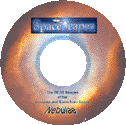

Copyright © Silkscape Arts - All rights reserved



